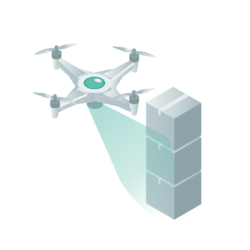Drones, or Unmanned Aerial Vehicles, are one of the youngest flying objects we know these days, with their public breakthrough for commercial use only about 20 years ago. In industry they have been applied much longer, though. They are used in e.g. agriculture, warehouse monitoring and inspection, logistics, and many other industries. Being relatively small, operating unmanned, and providing an overview of situations from above, it is interesting to explore new applications and improvements for drones and drone components in industry.
Manufacturing drones and drone components tailored to specific applications can lead to better performances by utilising optimal resources. This is also the project goal of MIND; which is an acronym of Manufacturing Innovations for Nextgen Drones. The MIND project consortium is built of Corvus Drones, LogiXair, and Bolk. Corvus is specialised in indoor greenhouse crop monitoring and inspection, LogiXair develops drones for logistic operations, and Bolk is a large logistics operator with its own warehouse.
Corvus and LogiXair are both experiencing a challenge to create lighter-weight drones and drone components. Producing lightweight drones requires proper material selection, properties understanding, and optimised drone geometry. Addressing this challenge leads to, amongst other things, a longer hauling flight time and complying with drone safety regulations.
Bolk, on the other hand, is currently experiencing increased efforts in monitoring and inspection time in their warehouse. Assisted by an automated drone inspection system, these efforts can be reduced without compromising the inspection standards.
Guided by the FIP-AM@UT, the organisations are bundling their forces and jointly work towards the design and development of a 3D printed drone or drone components to reduce the weight, and building demonstrators that successfully showcase the potential of these drones in visual inspection and logistics handling applications. The main focus will be on the design optimisation and material selection for additively manufactured drones, investigating the possibilities for inspection applications of drones with vision technology, and creating a proof-of-concept deliverable to show the applicability of drone technology in a warehouse and outdoor setting.









